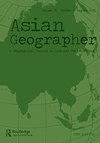Trans-Himalayan connectivity and sustainable tourism development in Nepal: a study of community perceptions of tourism impacts along the Nepal–China Friendship Highway
IF 2.2
Q2 GEOGRAPHY
引用次数: 4
Abstract
ABSTRACT With the introduction of China’s Belt and Road Initiative (BRI), the government of Nepal has agreed to develop links with China through the development of cross-border infrastructure such as railway and road networks. It is assumed that increased trans-Himalayan connectivity will bring new dynamics to the socioeconomic development of communities, and tourism is one of the significant factors behind the acceleration of such developments. Improved connectivity promotes accessibility, economic activity, and local development, along with increased tourism development. Most settlements along the Nepal–China Friendship Highway are expected to experience an increase in economic activity, tourism, and local development. In this regard, considering the cases of Dhulikhel and Banepa, key towns on the Nepal–China Friendship Highway, this research aims to explore the various impacts of transport infrastructure on tourism development and associated aspects of tourist destinations. Multiple methods of data collection, including interviews with key informants, questionnaire surveys, participant observations, and archival research have been adopted. Perceived impacts reveal positive and negative effects on infrastructure and tourism and to local communities. It is envisaged that integrated policies of sustainable tourism development and transport infrastructure should be in place.尼泊尔跨喜马拉雅地区的互联互通与旅游业的可持续发展:社区对尼中友谊公路沿线旅游业影响的认知研究
摘要随着中国“一带一路”倡议的提出,尼泊尔政府同意通过发展铁路和公路网等跨境基础设施发展与中国的联系。据推测,跨喜马拉雅连接的增加将为社区的社会经济发展带来新的动力,而旅游业是加速此类发展的重要因素之一。连通性的改善促进了可达性、经济活动和地方发展,同时也促进了旅游业的发展。尼中友谊公路沿线的大多数定居点预计将增加经济活动、旅游业和当地发展。在这方面,本研究以尼中友谊公路上的重点城镇Dhulikhel和Banepa为例,旨在探讨交通基础设施对旅游发展的各种影响以及旅游目的地的相关方面。采用了多种数据收集方法,包括对关键信息提供者的访谈、问卷调查、参与者观察和档案研究。感知的影响揭示了对基础设施和旅游业以及当地社区的积极和消极影响。据设想,应制定可持续旅游业发展和运输基础设施的综合政策。
本文章由计算机程序翻译,如有差异,请以英文原文为准。
求助全文
约1分钟内获得全文
求助全文
来源期刊

Asian Geographer
GEOGRAPHY-
CiteScore
3.30
自引率
0.00%
发文量
7
期刊介绍:
Asian Geographer disseminates knowledge about geographical problems and issues focusing on Asia and the Pacific Rim. Papers dealing with other regions should have a linkage to Asia and the Pacific Rim. Original and timely articles dealing with any field of physical or human geographical inquiries and methodologies will be considered for publication. We welcome, for example, submissions on people-environment interactions, urban and regional development, transport and large infrastructure, migration, natural disasters and their management, environment and energy issues. While the focus of the journal is placed on original research articles, review papers as well as viewpoints and research notes under the category of “Asian Geography in Brief” are also considered. Review papers should critically and constructively analyse the current state of understanding on geographical and planning topics in Asia. The ‘Asian Geography in Brief’ section welcomes submissions of applied geographical and planning research about Asia. The section aims to showcase (1) the diverse geography and planning of Asia; and (2) the diverse geographical and planning research about Asia. The journal will also publish special issues on particular themes or areas. Book reviews can be included from time to time.
 求助内容:
求助内容: 应助结果提醒方式:
应助结果提醒方式:


